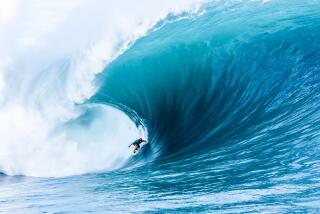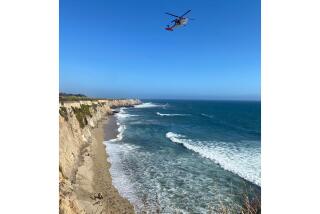Gone With the Wind : Technology: Pager created by local inventor signals when the best breezes blow so serious windsurfers can bolt for the beach.
- Share via
When the onshore wind begins to howl at Surfers Point in Ventura, Morgan Webber can hear its call from his financial consulting office in Oxnard.
So can Dave DePaolo from his Thousand Oaks law office and Dr. Steve Berrett from the radiology lab at St. John’s Pleasant Valley Hospital.
Each of these die-hard windsurfers carries a pager that chirps when the wind reaches a sailing speed of 13 m.p.h., the bare minimum needed to power their sails. Updates on the digital readout come every 10 minutes as the breeze builds.
“I don’t even think about the wind anymore, with this beeper,” said Webber, who used to spend almost as much time tracking the wind as he did the stock market. “But as soon as it goes off, I reschedule my appointments and I’m outta here.”
Windsurfers have long embraced innovation to help them jump higher off waves or skitter faster across the chop.
But this latest marriage of high technology and sport is changing the rituals of windsurfing culture--those that revolve around guys hanging out at the beach waiting for the wind.
In primitive times--that is, just a few years ago--the parking lot across from the Ventura County Fairgrounds would fill each afternoon with dozens of trucks and vans bearing masts, sails, boards and sailors with high-velocity dreams.
The guys in this male-dominated sport would spend hours sitting on tailgates, sipping beers, swapping stories or sizing up beach-goers.
Now the prime oceanfront parking slots remain empty for days on end. Yet once the onshore breeze hits a certain speed, a herd of windsurfers stampedes the lot, each tugged by the electronic leash fashioned by Ventura inventor Jim Martin.
“In a sense we have ruined the community,” said Martin, who now has 430 customers carrying his Call of the Wind pagers. “There are not as many girl-watchers down there any more, that’s for sure. But when it does blow, nobody misses it. And afterward, we all reminisce about how great it was.”
For the baby-boomer set, Martin’s wind pagers have arrived at a good time. As a group, windsurfers tend to be older than surfers, and richer. With their accumulated years and position come more responsibilities.
“I have a wife and two kids, so I just can’t go any time I want to,” said DePaolo, a 35-year-old Thousand Oaks attorney who carries the pager. “A high percentage of windsurfers are professionals. We have busier schedules now and can’t always clear out five-hour blocks of time to hang out and wait for the wind.”
The pager gives Webber a sense of security behind his cherrywood desk at the Smith Barney Inc. brokerage in Oxnard. He can focus on work, confident that he will hear his siren’s call if the wind picks up.
“Now, you don’t sit at work stressing, wondering if you should be in a meeting to make money or out there ripping in the surf,” he said.
Unlike other sports, windsurfing is limited to a narrow window of weather conditions.
The wind must hit at least a steady 13 m.p.h. before a billowing sail can lift a small, high-performance board out of the water so it can plane on the surface. Winds of 15 to 30 m.p.h. or more are needed for the kind of high-speed, wave-jumping thrills sought by the hottest sailors.
A sudden lull can ruin a sailing session. Short boards sink under a rider’s body weight. Windsurfers caught at sea are forced to drop their masts and bob in the ocean until a puff returns to carry them to shore.
All of these factors makes sailing time fleeting, if not fickle. And the fear of missing those precious moments inspired the Call of the Wind pagers.
Martin, one of the regulars at Surfers Point, persuaded a collection of friends three years ago to chip in and buy a $900 computer attached to a wind gauge.
The Windtalker, as the contraption is called, was developed for hang gliders. Once he installed it at the fairgrounds across from Surfers Point, Martin and his friends could telephone the computer and an electronic voice would announce up-to-the-minute wind conditions.
“I was calling it so much during the day, it was interfering with my job production,” said the 46-year-old Martin, a former general contractor. “I finally said, ‘OK, it’s time that I make the machine call me.’ ”
He spent the next eight months working with the Windtalker’s manufacturer to devise the pager system, and a new business was born. The computer measures the low, high and average wind speeds, wind direction and air temperature. Once the average speed hits 13 m.p.h., the automatic wind report beeps every pager and displays the particulars.
When Martin started to market his beepers, he had a tough time finding takers. So he started lending them to friends. When he tried to retrieve the pagers, no one would give them back.
“Once you’ve got it, it’s hard to give up,” said Ian Boyd, a UC Santa Barbara student and a top-ranked professional windsurfer. “It’s been great for me because the closest spots are a 45-minute drive, either Ventura or Jalama (Beach). It cuts down on all of the guesswork.”
Martin’s network now covers 14 popular windsurfing sites in California, stretching from Seal Beach to Marin County. Others locations in Southern California include Cabrillo Beach in San Pedro, Leo Carrillo State Beach north of Malibu and Lake Isabella near Bakersfield.
Martin recently wired three sites on Oahu and three on Maui and has two more planned for the Bay Area.
One potential investor wants to take the concept to Japan, and another is talking about expanding to Europe.
Like any new business, it’s still a daily struggle, Martin said. But a few new customers trickle in each day, forking over about $210 for the pager and $16 to $21 a month for the service, depending on how many sites will be monitored.
Martin estimates that about three-quarters of the serious windsurfers in Ventura and Santa Barbara counties subscribe to the service. As it begins to spread, hundreds have signed up in the Los Angeles Basin and the Bay Area.
“There are a few guys who still hang at the beach, and that is their lifestyle,” he said. “But for most of them, their time is very valuable.”
Steve Berrett, a radiologist at St. John’s in Camarillo, has traveled the world on windsurfing holidays. But the hospital’s daily demands, he said, prevent him from slipping away as often as he would like.
As the days grow longer, he hopes to begin catching quick sailing sessions after work. His beeper is poised on his belt to signal him when to bolt for the beach.
“I always keep a couple of boards and five or six sails and masts and booms in my Suburban,” Berrett said. “I’m ready at all times.”
More to Read
Sign up for Essential California
The most important California stories and recommendations in your inbox every morning.
You may occasionally receive promotional content from the Los Angeles Times.










